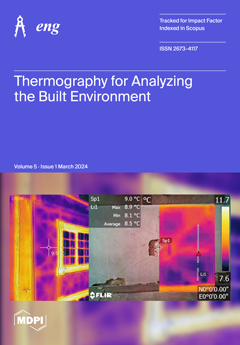This study investigates the biodegradation of Reactive Red 141 (RR 141), an azo dye prevalent in the textile industry, by bacteria isolated from activated sludge in a textile effluent treatment plant. RR 141, characterized by nitrogen–nitrogen double bonds (-N=N-), contributes to environmental issues
[...] Read more.
This study investigates the biodegradation of Reactive Red 141 (RR 141), an azo dye prevalent in the textile industry, by bacteria isolated from activated sludge in a textile effluent treatment plant. RR 141, characterized by nitrogen–nitrogen double bonds (-N=N-), contributes to environmental issues when improperly disposed of in textile effluents, leading to reduced oxygen levels in water bodies, diminished sunlight penetration, and the formation of potentially carcinogenic and mutagenic aromatic amines. This research focuses on identifying bacteria from activated sludge with the potential to decolorize RR 141. Microbiological identification employs MALDI-TOF-MS, known for its precision and rapid identification of environmental bacteria, enhancing treatment efficiency. Results highlight
Bacillus thuringiensis and
Kosakonia radicincitans as the most promising strains for RR 141 decolorization. Analysis of micro-organisms in activated sludge and database exploration suggests a correlation between these strains and the decolorization process. It is worth noting that this is the first report on the potential use of
K. radicincitans for azo dye decolorization. Three distinct culture media—BHI, MSG, and MS—were assessed to investigate their impact on RR 141 decolorization. Notably, BHI and MSG media, incorporating a carbon source, facilitated the bacterial growth of both tested species (
B. thuringiensis and
K. radicincitans), a phenomenon absent in the MS medium. This observation suggests that the bacteria exhibit limited capability to utilize RR 141 dye as a carbon source, pointing towards the influence of the culture medium on the discoloration process. The study evaluates performance kinetics, decolorization capacity through UV-VIS spectrophotometry, potential degradation pathways via HPLC-MS analysis, phytotoxicity, and enzymatic activity identification.
B. thuringiensis and
K.
radicincitans exhibit potential in decolorizing RR141, with 38% and 26% removal individually in 120 h. As a consortium, they achieved 36% removal in 12 h, primarily through biosorption rather than biodegradation, as indicated by HPLC-MS analyses. In conclusion, the research emphasizes the importance of exploring bacteria from activated sludge to optimize azo dye degradation in textile effluents.
B. thuringiensis and
K. radicincitans emerge as promising candidates for bioremediation, and the application of MALDI-TOF-MS proves invaluable for rapid and precise bacteria identification.
Full article





